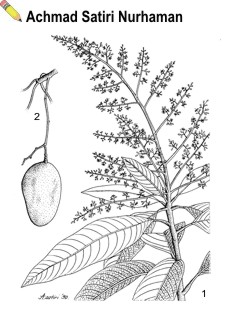Record Number
1523
PROSEA Handbook Number
2: Edible fruits and nuts
Taxon
Mangifera laurina Blume
Protologue
Mangifera laurina: Mus. Bot. Lugd. Bat. 1: 195 (1850).
Family
ANACARDIACEAE
Chromosome Numbers
2n = 40
Synonyms
— Mangifera laurina: Mangifera longipes Griffith (1854), Mangifera sumatrana Miq. (1859), Mangifera parih Miq. (1859).
Vernacular Names
— Mangifera laurina: Indonesia: mangga pari (Sundanese, West Java), pelem kecik (Javanese, East Java), empelem (Malay, Kalimantan, Sumatra). Malaysia: mempelam, emplam (Malay, Peninsular Malaysia, Sabah, Sarawak), mangga ayer (Malay, Sabah). Philippines: apali. Burma: thayet-thee-nee. Thailand: mamuang kaleng, mamuang khee kwaang (peninsula). Vietnam: cây nui, xoái nui.
Origin and Geographic Distribution
— Mangifera laurina is undoubtedly wild throughout the Malesian region, from peninsular Thailand to New Guinea, in lowland tropical rain forest. It was probably brought into cultivation long before the introduction of Mangifera indica L. in the region. In most parts of Borneo it is still widely cultivated, but it is now losing ground in Peninsular Malaysia, Sumatra and Java, since the fruit is inferior to that of Mangifera indica cultivars.
Uses
The fruit of both species has only a little bit of flesh which liquidifies at maturity, so that it can be sucked out. More often the fruit is harvested immature, sliced and served in fruit salads with a spicy sauce ('rujak').
Botany
— Mangifera laurina: tree, 20—30(—35) m tall, trunk 40—90(—150) cm in diameter, occasionally with short thick buttresses. Leaves elliptic-lanceolate to lanceolate, 6—24 cm x 2—6 cm, chartaceous, petiole slender, 2—5(—8) cm long. Inflorescences panicles, subterminal, pyramidal, 10—40 cm long, open, laxly spreading, glabrous or sub-puberulous, loosely flowered; flowers whitish-green to pale yellow, long-pedicelled, small, fragrant; calyx 5-lobed, petals 5, narrow; stamens 5, only 1 fertile. Fruit a drupe, exactly like a small mango, 6—10 cm x 4—5 cm, pale yellow at maturity; flesh yellow, soft, fibrous, juicy. Stone 4.5—5.5 cm x 2—3 cm x 1.3—1.6 cm; seed polyembryonic. By some authors (e.g. in Flora Malesiana) Mangifera laurina is merged into Mangifera indica; tree habit and leaves are very similar, so that Mangifera laurina is often mistaken for Mangifera indica. Its glabrous or sub-puberulous, laxly spreading, loosely flowered inflorescences are discriminative. Flowering can take place after any short dry spell. In South Kalimantan (Kandangan) a form with more elongated, narrower fruits is known as 'asem buluh', meaning 'bamboo mango'. In East Kalimantan, Mangifera laurina in village plantings in the lakes area sometimes crosses with the wild Mangifera gedebe Miq. of which there are important populations. The fruit shows intermediate characters, having notably labyrinthine seed.
Image
 | Mangifera laurina Blume - 1, flowering branch; 2, branchlet with fruit |
Ecology
Both species are at home in fairly wet tropical lowlands, Mangifera laurina also at elevations above 300 m.
Agronomy
Mangifera laurina is a suitable rootstock for cultivars of Mangifera indica grown on periodically inundated river banks in Kalimantan. The loose glabrous inflorescences show no sign of anthracnose (Colletotrichum gloeosporioides), where those of the mango are severely damaged.
Genetic Resources and Breeding
Both species might contribute to the improvement of Mangifera indica through breeding programmes. Crossing Mangifera laurina's resistance to anthracnose and the heavy fruit set of Mangifera pentandra into Mangifera indica would be a major breakthrough. Heavy fruit set may result from more intensive pollination in species with 3—5 fertile stamens instead of a single one. Five-stamen close relatives of Mangifera indica include Mangifera caloneura Kurz and Mangifera cochinchinensis Engl., which occur in mainland South-East Asia.
Prospects
It is to be expected that both species will continue to lose ground to the common mango. Their main role may lie in the hybridization of the mango.
Literature
Ding Hou, 1978. Anacardiaceae. In: van Steenis, C.G.G.J. (Editor): Flora Malesiana. Series 1. Vol. 8. pp. 426—428.
Mukherjee, S.K., 1949. A monograph of the genus Mangifera L. Lloydia 12: 73-136.
Fairchild, D., 1948. The mango relatives of Cochinchina; those with five-stamen flowers. Florida State Horticultural Society 61: 250—255.
Mukherjee, S.K., 1949. A monograph of the genus Mangifera L. Lloydia 12: 73-136.
Fairchild, D., 1948. The mango relatives of Cochinchina; those with five-stamen flowers. Florida State Horticultural Society 61: 250—255.
Author(s)
J.M. Bompard
Correct Citation of this Article
Bompard, J.M., 1991. Mangifera laurina Blume. In: Verheij, E.W.M. and Coronel, R.E. (Editors): Plant Resources of South-East Asia No 2: Edible fruits and nuts. PROSEA Foundation, Bogor, Indonesia. Database record: prota4u.org/prosea

All texts are licensed under a Creative Commons Attribution-Noncommercial-Share Alike 3.0 Netherlands License
This license does not include the illustrations (Maps,drawings,pictures); these remain all under copyright.